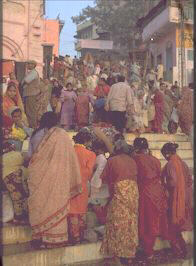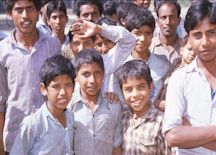|
By John S. James
 Shashank R. Joshi, M.D., president of the HOPE Foundation in
Mumbai, India, is an HIV specialist in a public hospital
system with more than 36,000 patients with HIV; in addition,
he follows over 500 HIV patients in his private practice, and
more than 180 HIV-discordant couples. We asked Dr. Joshi to
share information and experiences that might be useful to
physicians or patients elsewhere.
Shashank R. Joshi, M.D., president of the HOPE Foundation in
Mumbai, India, is an HIV specialist in a public hospital
system with more than 36,000 patients with HIV; in addition,
he follows over 500 HIV patients in his private practice, and
more than 180 HIV-discordant couples. We asked Dr. Joshi to
share information and experiences that might be useful to
physicians or patients elsewhere.
An Evolving Standard of Care in India
AIDS Treatment News: How to you approach HIV care in India,
where few patients have access to triple-drug combination
antiretroviral treatment?
Dr. Joshi: We are developing low-cost treatment models in the
Indian population, because of the high cost of antiretroviral
drugs.
A few of my private patients can afford some triple therapy
with a protease inhibitor and two nucleoside analogs, but not
continuously. So for some patients, we suggested triple
therapy on alternate months, one month on a HAART combination
and the next month without antiretrovirals.
At the end of a year we have a small cohort of 26 patients who have done very
well on this treatment; all of them have undetectable viral
load--below 20 copies on the Roche Ultrasensitive test--and
their average CD4 count has improved.
It is important to note
that all of these patients started this regimen with a CD4
count over 300. NIH is critically looking at this cohort. We
are now trying to validate these results, and are working
with other researchers, including in the U.S.
|
We are looking at other low-cost models as well. We do not
have ddI in India, so often I use d4T, 3TC, and hydroxyurea,
in an antiretroviral-naive population. [Note: Hydroxyurea, an
inexpensive drug usually used in cancer treatment, may
improve the activity of certain antiretrovirals, especially
ddI--but can also increase the toxicity of the regimen.]
This combination is working very well in a small but significant
number of cases, reducing viral load and inducing CTL
responses. Significantly, we have had no mitochondrial
toxicity in these patients--perhaps because we are giving
them appropriate immunonutrition, including multivitamins,
antioxidants, and certain other micronutrients.
|
Related Articles from the GayToday Archive:
AIDS Treatment Access
in Developing Countries
The Politics of Life and Death:
Global Responses to HIV and AIDS
Pharmaceutical Patents
& Developing Countries
Related Sites:
AIDS Treatment News
AIDS Crisis in India
GayToday does not endorse related sites.
|
This nutritional therapy may be particularly important in the
Indian population, because wasting is a major problem. [Note:
Some researchers believe that mitochondrial toxicity--a
condition recognized elsewhere in medicine--may caused by
nucleoside analog drugs--and may be responsible for much of
their toxicity, as well as some but not all of the body-shape
changes often attributed to protease inhibitors.]
We are planning to study the product ImmunoCal, a nutritional
supplement derived from whey protein, as a source of
glutathione. It is believed that mitochondrial toxicity,
which the nucleoside analog drugs and hydroxyurea may have,
is mediated through the glutathione pathway.
If you give patients a natural source of glutathione, maybe this problem
can be prevented, and you may not see the liver toxicity,
lactic acidosis, or other problems which might otherwise
occur. We want to see if improved nutrition can improve the
catabolic cachexia [wasting], and also we want to look for
any antiretroviral effect. I understand that a small but
significant number of patients have dropped their viral load
by a log, after treatment with nutritional regimens designed
to support the immune system.
So an evolving standard of care in India is that we offer
patients antiretroviral therapy with two nucleoside analogs
and a protease inhibitor; if they cannot afford that, they
can try structured treatment interruption, one month on and
one month off of the triple therapy; if they cannot afford
that, we look into an option like d4T and 3TC and
hydroxyurea. In any case, treatment includes multivitamins
and antioxidant supplements, psychological support, and
meditation and yoga.
Our protocol always includes vitamin E and vitamin C. We try
to get the vitamin E from natural sources; we do not use the
synthetic pills because they are derived from petrochemical
intermediates, and some believe that these preparations might
be pro-oxidant as well as antioxidant. So we use extracts
from wheat germ, usually 200 IU to 400 IU. We also include B-
complex vitamins, selenium, and other minerals.
Herbal Treatments for Antiretroviral or IL-2 Effects
 Dr. Joshi: We are also using certain herbal medications--some
of which increase the body's natural production of IL-2. We
presented a poster on this approach in 1998, at the 12th
World AIDS Conference in Geneva ["Effect of unique herbal
formulation in Indian HIV patients: A pilot study," 12th
World AIDS Conference, Geneva, June 28 - July 3, 1998,
abstract #42385].
Dr. Joshi: We are also using certain herbal medications--some
of which increase the body's natural production of IL-2. We
presented a poster on this approach in 1998, at the 12th
World AIDS Conference in Geneva ["Effect of unique herbal
formulation in Indian HIV patients: A pilot study," 12th
World AIDS Conference, Geneva, June 28 - July 3, 1998,
abstract #42385].
We have compiled an herbal booklet, listing
each ingredient, with references to studies showing antiviral
activity, or increases in the natural production of IL-2.
De-Worming, and Other Treatment for Intestinal Inflammation
Dr. Joshi: We are also giving a weekly dose of albendazole to
patients who have intestinal parasites. We have seen that if
we de-worm patients routinely, after six months to a year
there is a reduction of viral load.
Indian patients traditionally have higher viral set points than European
patients; this might be related to the parasites. Deworming
might assist mucosal immunity in the gut, and improve the CTL
response against HIV. Also, in a couple of patients, I am
trying mesalamine, a drug used to reduce intestinal
inflammation.
Side Effects of Antiretroviral Regimens
Dr. Joshi: We have not had problems with mitochondrial
toxicity--perhaps because of our nutritional therapy, or
perhaps because we do not have ddI in India. I also believe
that immunonutrition helps to some extent with lipodystrophy.
But we are seeing lipodystrophy. And we are also seeing other
side effects which have been reported elsewhere, including
osteoporosis, and aseptic necrosis of the femur, in people on
protease-inhibitor regimens in India.
So there is considerable concern about these drugs, and we are looking at
PI-sparing regimens. Nevirapine is now available in India,
and we will be using it for this purpose.
AIDS Treatment News
Published twice monthly
Subscription and Editorial Office:
P.O. Box 411256
San Francisco, CA 94141
800/TREAT-1-2 toll-free U.S. and Canada
415/255-0588 regular office number
Fax: 415/255-4659
E-mail: aidsnews@aidsnews.org
Editor and Publisher: John S. James
Associate Editor: Tadd T. Tobias
Reader Services: Tom Fontaine and Denny Smith
Operations Manager: Danalan Richard Copeland
Statement of Purpose:
AIDS Treatment News reports on experimental and standard treatments, especially those available now. We interview physicians, scientists, other health professionals, and persons with AIDS or HIV; we also collect information from meetings and conferences, medical journals, and computer databases. Long-term survivors have usually tried many different treatments, and found combinations which work for them. AIDS Treatment News does not recommend particular therapies, but seeks to increase the options available.
Subscription Information: Call 800/TREAT-1-2 Businesses, Institutions, Professionals: $270/year. Includes early delivery of an extra copy by email. Nonprofit organizations: $135/year. Includes early delivery of an extra copy by email. Individuals: $120/year, or $70 for six months. Special discount for persons with financial difficulties: $54/year, or $30 for six months. If you cannot afford a subscription, please write or call. Outside North, Central, or South America, add air mail postage: $20/year, $10 for six months. Back issues available. Fax subscriptions, bulk rates, and multiple subscriptions are available; contact our office for details. Please send U.S. funds: personal check or bank draft, international postal money order, or travelers checks.
ISSN # 1052-4207
Copyright 2000 by John S. James.
|







